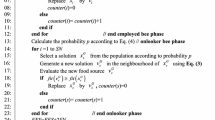Abstract
The artificial bee colony (ABC) is a popular heuristic optimization algorithm. Although it has fewer control parameters, it shows competitive performance compared with other population-based algorithms. The ABC algorithm is good at exploration, but poor at exploitation. Recently, a global best-guided ABC (GABC) algorithm, inspired by particle swarm optimization, has been developed to tackle this issue. However, GABC cannot be applied to binary optimization problems. In this paper, we develop an improved ABC (IABC) algorithm with a new food source update strategy. IABC employs information about the global best solution as well as personal best solutions, thus enhancing the local search abilities of the bees. The new algorithm is adjusted to solve the binary optimization problem of minimal time cost reduction. We conduct a series of experiments on four UCI datasets, and our results clearly indicate that our algorithm outperforms the existing ABC algorithms, especially on the medium-sized Mushroom dataset.



Similar content being viewed by others
References
Karaboga D, Akay B (2009) A comparative study of artificial bee colony algorithm. Appl Math Comput 214(1):108–132
Sundar S, Singh A (2010) A swarm intelligence approach to the quadratic minimum spanning tree problem. Inf Sci 180(17):3182–3191
Karaboga D, Akay B, Ozturk C (2007) Artificial bee colony (ABC) optimization algorithm for training feed-forward neural networks. Model Decisions Artif Intell 4617:318–329
Karaboga N (2009) A new design method based on artificial bee colony algorithm for digital IIR filters. J Franklin Inst 346(4):328–348
Linh NT, Anh NQ (2010) Application artificial bee colony algorithm (ABC) for reconfiguring distribution network. In: Second International Conference on Computer modeling and simulation. ICCMS’10, Vol. 1, IEEE. 2010. pp 102–106
Chang WL, Zeng D, Chen RC, Guo S (2013) An artificial bee colony algorithm for data collection path planning in sparse wireless sensor networks. Int J Machine Learn Cybern 4:1–9
Rajasekhar A, Abraham A, Pant M (2011) A hybrid differential artificial bee colony algorithm based tuning of fractional order controller for permanent magnet synchronous motor drive. Int J Mach Learn Cybern 4:1–11
Blum C, Roli A (2003) Metaheuristics in combinatorial optimization: overview and conceptual comparison. ACM Comput Surveys (CSUR) 35(3):268–308
Zhu GP, Kwong S (2010) Gbest-guided artificial bee colony algorithm for numerical function optimization. Appl Math Comput 217(7):3166–3173
Rana S, Jasola S, Kumar R (2012) A boundary restricted adaptive particle swarm optimization for data clustering. Int J Mach Learn Cybern 4:1–10
Wang XZ, He YL, Dong LC, Zhao HY (2011) Particle swarm optimization for determining fuzzy measures from data. Inf Sci 181(19):4230–4252
Kıran MMS (2013) Xor-based artificial bee colony for binary optimization. Turkish J Electrical Eng Comput Sci 21:2307–2328
Kashan MH, Nahavandi N, Kashan AH (2012) Disabc: a new artificial bee colony algorithm for binary optimization. Appl Soft Comput 12(1):342–352
Cai JL, Ding HJ, Zhu W, Zhu XZ (2013) Artificial bee colony algorithm to minimal time cost reduction. J Comput Inf Systems 9 (21):8725–8734
Min F, He HP, Qian YH, Zhu W (2011) Test-cost-sensitive attribute reduction. Inf Sci 181:4928–4942
Zhang S (2010) Cost-sensitive classification with respect to waiting cost. Knowl Based Systems 23(5):369–378
Nguyen S, Pallottino S (1988) Equilibrium traffic assignment for large scale transit networks. Eur J Oper Res 37(2):176–186
Cromwell DA (2004) Waiting time information services: an evaluation of how well clearance time statistics can forecast a patient’s wait. Soc Sci Med 59(9):1937–1948
Ji S, Carin L (2007) Cost-sensitive feature acquisition and classification. Pattern Recognit 40(5):1474–1485
Sheng VS, Ling CX (2006) Feature value acquisition in testing: a sequential batch test algorithm. In: Proceedings of the 23rd International Conference on Machine Learning, ACM 809–816
Min F, Zhu W (2012) Attribute reduction of data with error ranges and test costs. Inf Sci 211:48–67
Min F, Zhu W, Zhao H, Pan GY, Liu JB, Xu ZL (2012) Coser: cost-senstive rough sets. http://grc.fjzs.edu.cn/~fmin/coser/
Min F, Liu Q (2009) A hierarchical model for test-cost-sensitive decision systems. Inf Sci 179(14):2442–2452
Pawlak Z (1982) Rough sets. Int J Comput Inf Sci 11:341–356
Zhang W, Mi J, Wu W (2003) Knowledge reductions in inconsistent information systems. Chin J Comput 26(1):12–18
Jensen R, Shen Q (2004) Semantics-preserving dimensionality reduction: rough and fuzzy-rough-based approaches. IEEE Transact Knowl Data Eng 16(12):1457–1471
Yao YY, Zhao Y (2008) Attribute reduction in decision-theoretic rough set models. Inf Sci 178(17):3356–3373
Zhu W (2009) Relationship among basic concepts in covering-based rough sets. Inf Sci 179(14):2478–2486
Zhu W, Wang F (2003) Reduction and axiomization of covering generalized rough sets. Inf Sci 152(1):217–230
Karaboga D (2005) An idea based on honey bee swarm for numerical optimization. Techn. Rep. TR06, Erciyes Univ. Press, Erciyes
Bae C, Yeh WC, Chung YY, Liu SL (2010) Feature selection with intelligent dynamic swarm and rough set. Expert Systems Appl 37(10):7026–7032
Song MP, Gu GC (2004) Research on particle swarm optimization: a review, In: Machine learning and cybernetics. Proceedings of 2004 International Conference on, Vol. 4, IEEE, 2004, 2236–2241
Blake CL, Merz CJ (1998) UCI repository of machine learning databases. http://www.ics.uci.edu/~mlearn/mlrepository.html
Acknowledgments
This work is in part supported by the National Science Foundation of China under Grant Nos. 61379089, 61379049, 61170128.
Author information
Authors and Affiliations
Corresponding author
Rights and permissions
About this article
Cite this article
Cai, J., Zhu, W., Ding, H. et al. An improved artificial bee colony algorithm for minimal time cost reduction. Int. J. Mach. Learn. & Cyber. 5, 743–752 (2014). https://doi.org/10.1007/s13042-013-0219-8
Received:
Accepted:
Published:
Issue Date:
DOI: https://doi.org/10.1007/s13042-013-0219-8




